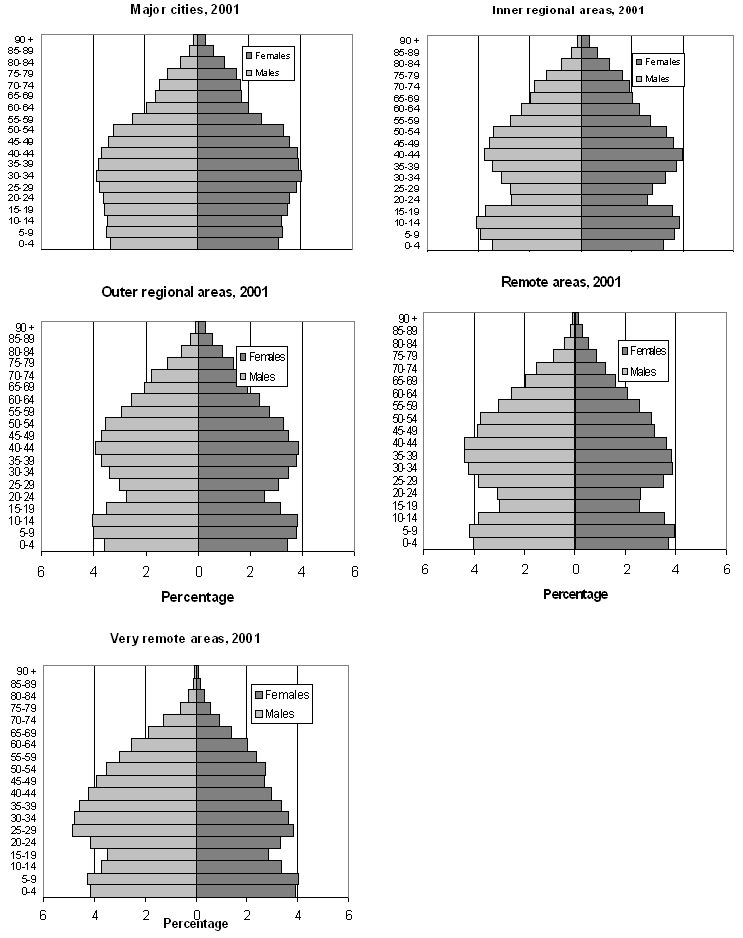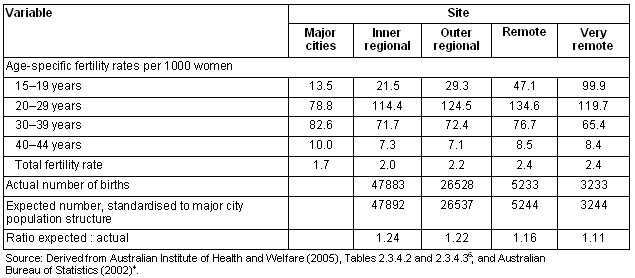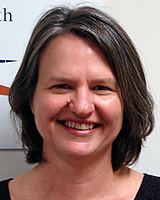Introduction
Age-sex pyramids are the tea leaves in which we read present and future of health challenges. As Australian Treasurer Peter Costello is fond of declaring, demography is destiny1. While the national implications of population change have been thoroughly discussed2, there is less understanding of the unique pattern of demographic features that seal the fate of rural and remote communities. These challenges have to be addressed if their residents are to remain healthy.
First, a caveat. It is axiomatic in discussing rural and remote Australia that diversity rules. If you have seen one country town, you have seen only one country town. Nevertheless, too much attention to differences can obscure a number of robust generalisations. In this paper I use the Australian Standard Geographical Classification (ASGC) Remoteness Areas classification to distinguish between major cities, regional centres close to major cities (inner regional areas), regional centres some distance from other large service centres (outer regional areas) and remote and very remote areas that are even further away. This system allocates every part of Australia based on the road distance to the nearest five service centres of specific sizes. It represents residents' access to goods and services3.
Populations grow or decline through births, deaths and net-migration. These three components shape the characteristics of populations: the proportion of people in different age groups, the relative numbers of males and females and the size of sub-groups such as Indigenous people. Population composition and size has a huge impact on the health status of communities and the type and amount of health services required.
Figure 1 shows the population pyramids for the five ASGC remoteness areas, derived from the 2001 census data available from the Australian Bureau of Statistics (ABS)4. The most obvious features are the 'bites' taken out of the four rural and remote pyramids. These missing chunks indicate that rural and remote Australia has a deficit of young adults. Looking more closely at the pyramids one can see that children under 15 years of age make up a slightly higher proportion of the population outside of major cities. In remote and very remote areas males are more numerous than females at all ages. Compared with major cities, older residents make up a much larger proportion of the inner regional cities, about the same proportion in outer regional populations and a smaller proportion in the remote and very remote regions. These patterns are summarised (Table 1).

Figure 1: Population pyramids for remoteness areas of Australia, 2001.
Table 1: Age and sex structure of the Australian population by remote classification, 2001

Young adults and fertility
The lack of young rural and remote adults is the result of high rates of migration to cities. This is a consistent feature across all non-metropolitan regions of Australia, regardless of regions' natural amenities or economic robustness5.
A demographic and health consequence of the loss of young adults is the resulting loss of children either because they move with the adults or because they are born elsewhere. A useful demographic measure is the 'total fertility rate' (TFR). This has an agreeable interpretation of the number of children that the average woman will bear during her lifetime. It is deceptively simple because it is not a measure of the actual life experiences of women but is instead based on a 'synthetic cohort', that is the age-specific fertility rates of women at a single point in time. Table 2 shows that the young women who remain outside major cities are very likely to have children. With greater remoteness, the TRF is higher, but what is an even greater difference is the extent that rural and remote fertility is concentrated in younger ages6. This results in quite different life-experiences for urban, rural and remote young women. Women's Health Australia, a national longitudinal study, found that only 23% of urban women aged 25-30 years were living with a child or children, compared with 39% in large rural centres, 46% in small rural centre and 47% in other rural or remote locations7.
Table 2: Selected measures of fertility by remoteness area, 2000-2002

However, compared with major cities, there are relatively few rural women in their 20s and 30s. With some demographic imagining, we can conjure up a rural and remote population that has the same total population size, but an age and sex distribution that is the same as found in major cities. Such a population would have a much higher proportion of women in their childbearing ages. If those women retained the higher fertility rates from their area, then, as Table 2 also shows, the absolute number of births would range from almost 25% more in inner regional areas to 10% more in remote areas. This is calculated by multiplying the age-specific birth rates for each remoteness area6 by the number of women who would be in each age group if the population distribution was the same as that found in the cities.
Why are rural and remote young women having children earlier? The normal reasons given are a cultural preference for early family formation, strengthened by lack of educational or employment alternatives. Yet, demography also plays a large factor. Known as the 'marriage squeeze', demographers have known for centuries that age at marriage and the birth of the first child is strongly related to the balance or imbalance in the sexes. Outside major cities, females aged 20-24 years are less numerous than males 25-29 years; the same is true in the next five-year age group. With the median age at first marriage 2 years older for males than females, young women have more choice of partners, and one of the results is that babies come earlier8.
The health implications of these patterns are fairly clear. Rural and remote antenatal and obstetric services will be at risk because of small and declining absolute numbers, and because of a proportionately smaller number of births than would be expected from the size of the present population. However, the impact of the reduced services will be felt more greatly by rural and remote communities because of the much higher proportion of young women who have children.
Growing Indigenous population
As has been well documented, Indigenous people still experience mortality and morbidity rates two to three times higher than non-Indigenous people. It is also well known that with increasing remoteness Indigenous Australians comprise a greater proportion of the total population (Table 3). Only 31% of Indigenous people live in major cities compared with 67% of non-Indigenous people. The poorer health of remote residents is frequently 'explained' by the high proportion of Indigenous people. However, other population dynamics compound these health inequities9.
Table 3: Size and age structure of the Indigenous and non-Indigenous population by remoteness area, 2001

Unlike the total rural and remote population, the Indigenous population, especially outside the major cities, is growing rapidly. John Taylor has estimated that in the interior or desert region of Australia, most of which is encompassed by the remote and very remote classifications, the total population will grow 5.8% between 2001 and 2016 while the Indigenous population will grow 22.4%10. This type of growth is not recent. Between 1981 and 1996 the Indigenous population of a similar region grew 23% compared with an absolute decline in the size of the non-Indigenous population11.
Higher fertility is one reason for the population increase. Indigenous women have more children than non-Indigenous women, even though the gap is narrowing rapidly11. Analysis of the 2001 census suggests that the TFR for Indigenous women was only 2.3, a figure very close to replacement level. This low level of fertility is the culmination of a steady fertility decline since the 1970s. In more remote areas Indigenous fertility rates are still well above replacement level. For example, TFRs are estimated to be above 3 in Cape York Pennisula, Queensland and in East Pilbara, Western Australia12,13.
The Indigenous people who live in remote and rural areas are much less likely to move to more urban locations and therefore the Indigenous population does not experience the same drain of young adults as non-Indigenous rural and remote populations. Other reasons for the growth are Indigenous babies born to non-Indigenous mothers - conventional fertility rates underestimate the extent of natural increase through births, better enumeration of Indigenous people in the census and a greater propensity for people to identify as Indigenous. It is likely that the first two reasons are more important in remote and very remote Australia.
The consequence of these different population dynamics is that the Indigneous population is increasing both in absolute terms and as a proportion of the total population. In many parts of rural and remote Australia, Indigenous towns and a rising Indigenous presence is emerging, with distinct social, economic and health needs14.
Older adults and population decline
The implications of population ageing have been discussed extensively in the popular and academic media but ageing in rural and remote Australia has unique features and causes. First, there is a greater proportion of older men than one finds in the cities (Table 1). This is especially true in the remote locations and is a reflection of the higher proportion of males at all ages in these areas. But the proportion of men in rural centres is also higher than would be found in major cities. Hospitals will face the greatest pressure, because older men have higher hospitalisation rates than older women. The broader community will also share this burden because older men in remote areas are much less likely be married than and therefore less likely to have someone who can look after them at home.
The second unique feature of rural ageing is that it is being fuelled by migration. Nationally and in urban areas, population ageing is being caused by low fertility. As we have seen, fertility is also below replacement in rural and remote areas. In addition out-migration of young adults in their early childbearing years means an even greater loss of births. This means that most rural and remote areas will experience population decline sooner than cities.
The ABS routinely calculates regional population growth rates15. By classifying each SLA into a remoteness area, one learns that the annual mean population growth rate for statistical local areas (SLAs) between 1998 and 2003 was 3.6% in major cities, 1.0% in inner regional areas, 0.3% in outer regional areas, and -0.8 and -0.15% in remote and very remote areas. The modest growth rates of regional centres masks the fact that 30% of inner regional and 56% of outer regional SLAs had zero or negative growth in that time.
Population decline in remote areas is primarily caused by more people moving out of the area than moving in. In the inner and outer regions, population decline is also associated with a high proportion of older residents as well as the loss of young adults and low fertility. Based on the 2001 census, the mean percentage of residents 65 years and older in SLAs is 11.9%4. Inner and outer regional SLAs are more likely to have older populations: 27% and 22% respectively of these SLAs have 16% or more of their population over 65 years old. Those same 'very old' SLAs are more likely to be experiencing zero or negative growth compared with younger SLAs: 36% of very old inner regional SLAs have zero or negative growth compared with 28% of younger SLAs; the comparable figures for outer regional SLAs are 64% and 54%.
In some rural areas this process of ageing through natural increase is being exacerbated by the in-migration of older residents seeking a conducive retirement or pre-retirement home. Natalie Jackson has demonstrated this in Tasmania where a recent increase in the number of in-migrants has been disproportionately comprised of people over age 4016. If these in-migrants remain, it will only be a matter of time before they face a growing need of services - in a rural state that has few young adults to meet those needs. A greater range of telehealth solutions is one response that the health sector can make but there will need to be more strategies as well. Jackson proposes that the service needs of older residents may actually lead a consumer-driven pull encouraging young Tasmanians to stay for employment. However, this optimistic scenario would reverse a long and pervasive pattern of young people leaving country towns and regional centres for cities.
Policy implications
Local government, other local services and the communities themselves are usually left to respond to demographic challenges. Rural and remote populations are shaped by different population dynamics than those in major cities. The vast majority of localities in Australia are outside major cities and most of them are struggling with population issues that are different from the urban and therefore national experience.
Responding to rural and remote health challenges requires political and social will. Some of these responses have already been made. Increased access to aged care facilitates and services in rural areas recognises that these communities will be the first to undergo profound population ageing. However, Commonwealth grants formula still rewards communities with young adults rather than compensates those needing to serve an ageing population17.
The unique fertility patterns in rural and remote areas mean that maternal and child health services are undersupplied. Older adults' and particularly men's chronic and acute health problems put a usually high burden on hospital services, making conventional benchmarking of case-mixes irrelevant or misleading. Perhaps most importantly, there has been a failure to systematically respond with more culturally and epidemiologically appropriate health services in areas that are becoming increasingly Indigenous communities. The services designed for a small, declining non-Indigenous population are straining to deliver the same level of service to a younger, growing population of Indigenous people with a much higher disease burden.
Acknowledgements
Combined Universities Centre for Rural Health is funded by the Australian Department of Health and Ageing.
References
1. Costello P. Australia's demographic challenges. (Online) 2004. Available: http://www.treasurer.gov.au/tsr/content/speeches/2004/003.asp (Accessed 26 January 2006).
2. The Treasury. Australia's demographic challenges: discussion paper. (Online) 2004. Available: http://demographics.treasury.gov.au (Accessed 26 January 2006).
3. Australian Institute of Health and Welfare. Rural, regional and remote health: a guide to remoteness classifications. AIHW cat. no. PHE 53. Canberra: AIHW; 2004.
4. Australian Bureau of Statistics. 2001 Census Basics. Canberra: ABS, 2002. [CD-ROM].
5. Stillwell J, Bell M, Blake M, Duke-Williams O, Rees P. Net migration and migration effectiveness: a comparison between Australia and the United Kingdom, 1976-96. Part 2: Age related migration patterns. Journal of Population Research 2001; 18: 19-39.
6. Australian Institute of Health and Welfare. Rural, Regional and Remote Health: Indicators of Health. AIHW cat. no. PHE 59. Canberra: AIHW, 2005.
7. Hockey R. Data Book for Survey 3 of the Younger Cohort 2003 (25-30 years) Newcastle: The Australian Longitudinal Study on Women's Health. (Online) 2005. Available: http://www.newcastle.edu.au/centre/wha/surveys.html (Accessed 26 January 2006).
8. Australian Bureau of Statistics. Marriages and Divorces, Australia 2002. ABS Cat. no. 3310.0.Canberra: ABS, 2003.
9. Australian Institute of Health and Welfare. Rural, regional and remote health: a study on mortality. AIHW cat. no. PHE 45. Canberra: AIHW, 2003.
10. Taylor J. Population futures in the Australian desert, 2001-2016. CAEPR Discussion Paper no. 231. Canberra: Centre for Aboriginal Economic Policy Research, The Australian National University, 2002.
11. Taylor J. Indigenous Australians: the first transformation. In: S-E Khoo, P McDonald (Eds). The transformation of Australia's Population: 1970-2030. Sydney: UNSW Press, 2003; 17-39.
12. Taylor J, Bell M. The Indigenous population of Cape York Peninsula, 2001-2006. CAEPR Discussion Paper No. 189. Canberra: Centre for Aboriginal Economic Policy Research, The Australian National University, 2002.
13. Aitchison S. Pilbara Health Profile. South Hedland: Pilbara Population Health Unit, 2004.
14. Ross K, Taylor J. The relative social and economic status of Indigenous people in Bourke, Brewarrina and Walgett. CAEPR Working Paper No. 8. Canberra: Centre for Aboriginal Economic Policy Research, The Australian National University, 2001.
15. Australian Bureau of Statistics. Regional Population Growth Australia and New Zealand 2002-03. ABS Cat. no. 3218.0. Canberra: ABS, 2004.
16. Jackson N. Tasmania's turnaround? Migration in the Apple Isle. Dialogue 2005; 24(2): 25-37.
17. Jackson N. Regional population ageing and local government funding: a tentative consideration of the issues. Australasian Journal of Regional Studies 2004; 10: 77-103.
Abstract
Demography is the study of the size and composition of populations. Populations change size through births, deaths and net-migration. Over time, mortality, fertility and migration patterns create populations that may be large or small, young or old, growing or declining. Rural and remote Australia has a unique demography that determines its health problems and health service needs. The tendency of young adults to leave rural and remote areas for cities means that they leave behind communities which are, on average, older than those found in the cities. Rural and remote women have slightly more children at significantly younger ages, but because of out-migration, the actual number of babies born outside of the cities is smaller than would be expected. Most rural and remote areas already have a high proportion of their population over 65 years old. Many communities with an older population are declining in absolute numbers but the need for health services may be greater than required for smaller, younger communities. In contrast to the trends in total population, the rural and remote Aboriginal and Torres Strait Islander population is growing rapidly. This is the result of a higher proportion of young people, higher fertility rates and lower rates of moving to cities. The health characteristics of rural and remote Australia increasingly reflects the higher morbidity of Indigenous and older people. Responding to this demographic destiny is the present and future challenge.
Key words: Aboriginal and Torres Strait Islanders, demography, rural health.
You might also be interested in:
2022 - Factors associated with adolescent birth in Indonesia: a national survey
2015 - People living in remote communities can have best-practice diabetes care
